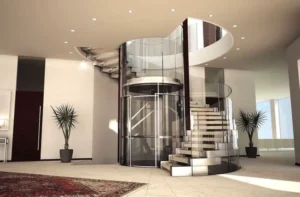Adding an elevator to your home can transform the way you live—boosting mobility, property value, and day-to-day convenience. But here’s the catch: installing a residential elevator isn’t as simple as adding another appliance. There are critical technical details, safety requirements, and long-term performance considerations that, if overlooked, can turn your dream upgrade into a maintenance nightmare.
Having worked with hundreds of homeowners over the years at LJ Elevator, we’ve seen where things go wrong—and more importantly, how to get them right. So let’s break down the five most common mistakes homeowners make when installing a home elevator, and how to make sure you avoid every one of them.

1. Ignoring structural requirements early in the design
One of the most common mistakes homeowners make is failing to consider elevator structural requirements during the early design stage—or thinking it’s impossible to add one once the house is built.
But here’s the good news: it’s never too late—if you choose the right elevator.
At LJ Elevator, we offer both compact pitless models like our SEVA and VIKA series, and traditional home elevators with deeper shaft and headroom requirements. This means we can meet the needs of homeowners who:
- Are still designing their home and want to integrate an elevator from the ground up (traditional or compact—your choice);
- Or are looking to retrofit an elevator into a completed property, where space or foundation modifications may be limited.

Our SEVA and VIKA models are ideal for renovations or space-sensitive layouts, as they require no deep pit or machine room and offer a slim, space-saving shaft design. On the other hand, our standard traction elevators provide robust travel ranges and customization for homes with more flexibility.
Whichever you choose, our team offers remote technical guidance for overseas clients, helping you assess feasibility, adjust plans, and avoid costly redesigns later.
2. Choosing the wrong drive system for your needs
Home elevators come in various drive types—hydraulic, traction, vacuum, screw-type—and each has its pros and cons. The mistake? Many buyers go for what sounds high-tech or cheap, without considering noise levels, energy efficiency, maintenance frequency, or suitability for the building.
For example, our LJ Elevator belt-driven traction models (like the UNA, SEVA, and VIKA series) are optimized for private homes. They offer smoother rides, quieter operation, and reduced maintenance thanks to our patented steel-belt drive system. Compared to older hydraulic systems, they’re more space-efficient, consume less power, and last longer without needing messy oil changes.

3. Underestimating the importance of safety features
Some homeowners focus on aesthetics and forget what really matters: getting out safely if something goes wrong. Many low-end models come with only basic safety protections—or worse, misleading marketing.
For example, some companies advertise “one-touch rescue” functions that are actually just emergency call buttons connecting to service staff. At LJ Elevator, we offer real one-touch self-rescue. In the event of a power outage or control fault, passengers can press and hold the rescue button, and the elevator will automatically descend at low speed to the nearest floor and open the door for a safe exit—without waiting for outside help.

This isn’t just a feature. It’s patented technology, one of the reasons our lifts are trusted in over 30 countries worldwide.
4. Skipping long-term maintenance planning
Elevators are long-term investments. Yet, many buyers fail to consider who will maintain their system, whether parts are easy to replace, or how remote support works—especially if they’re overseas.
At LJ Elevator, we’ve designed our residential lifts with modular components and cloud-based diagnostic systems, making maintenance easy and remote troubleshooting possible. We also offer detailed installation manuals, real-time video support, and multilingual guidance for international clients—so you don’t have to worry if you’re halfway across the globe.
5. Overlooking code compliance and certifications
Residential elevators must meet strict standards depending on the region—whether that’s EN 81-41 in Europe or ASME A17.1 in North America. Some homeowners unknowingly purchase non-compliant systems, leading to denied permits, fines, or worse—unsafe operation.
All of LJ Elevator’s products are built to meet or exceed international safety standards. We provide full compliance documentation, and our engineering team stays up to date with global code changes to help you make informed decisions.
Conclusion:
Installing a home elevator is a major step toward smarter living. But like any smart investment, the outcome depends on the planning. By avoiding these five common mistakes and partnering with a company that prioritizes both safety and support, you’ll enjoy peace of mind and long-lasting performance.
At LJ Elevator, we don’t just sell elevators—we engineer vertical mobility solutions. From our patented self-rescue system to our sleek, steel-belt traction technology, we bring together innovation, safety, and support under one roof.
And while we can’t physically be on-site for overseas projects, our experienced technical team is always just a click away, offering real-time assistance, tailored drawings, and precise installation guidance every step of the way.





